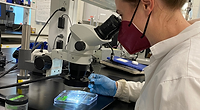Oregon-Based Study Shows Widespread Microplastics Contamination in Seafood

Image credit: manfredrichter via Pixabay
Yet another study is pointing to the issue of microplastics contamination in the food chain. Specifically, according to a study recently published in Frontiers in Toxicology, microplastics are widely present in commonly eaten Oregon seafood.
For the study, researchers sampled five finfish (Chinook salmon, black rockfish, lamprey, lingcod, and Pacific herring) and one shellfish species (pink shrimp) caught in Oregon waters. The samples were retrieved from both fishing boats and at retail. A total of 182 samples (122 finfish and 60 crustaceans) were collected.
Approximately 1,800 microplastic particles were found in 180 of the 182 seafood samples, with microplastic fibers the most common type of particle (81.17 percent), followed by fragments (18.38 percent) and films (0.44 percent). The researchers observed that fibers were able to migrate from the fishes’ guts into their edible muscle tissues.
Pink shrimp was the species with the most microplastics per sample, probably due to their filter-feeding nature and residing just below the surface of the water. Chinook salmon contained the least concentrations of plastic per sample, followed by black rockfish and lingcod.
Additionally, the researchers experimented with rinsing retail-purchased fish fillets and shrimp as a consumer would do at home, to determine whether rinsing would affect the presence of plastics introduced to the surface of the fish through processing and packaging. They found that, in some cases, additional surface contamination can be removed with rinsing.
Although the study demonstrates widespread microplastics contamination in seafood, the researchers are not advocating for consumers to eat less fish, pointing out that plastic contamination is also true for water, meat and poultry, tofu, and other food types. Because of the presence of microplastics in the environment, these pollutants will enter the food chain through soil and water.
The research was led by Summer Traylor, M.S. of Portland State University, assisted by Elise Granek, Ph.D., Professor of Environmental Science and Management at PSU, and Susanne Brander, Ph.D., exotoxicologist and Associate Professor in Oregon State University’s College of Agricultural Sciences. Dr. Granek’s and Dr. Brander’s laboratories are currently involved in projects exploring solutions to environmental microplastics contamination affecting the food chain. For example, with a $1.9 million grant from the U.S. National Oceanic and Atmospheric Administration's (NOAA), Dr. Granek is developing filters for washing machines, dishwashers, and clothes driers that could catch microplastics. Another project Dr. Granek and Dr. Brander are taking part in, which is funded by the Oregon Sea Grant, will explore the efficacy of catch basin filters for stormwater drains in trapping microplastics from road runoff before entering waterways.
Looking for a reprint of this article?
From high-res PDFs to custom plaques, order your copy today!







